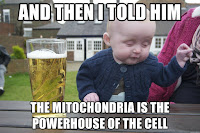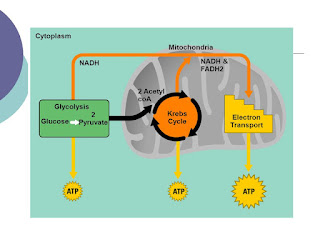I'm not joking.
At Marblehead, there were four biology teachers. Three of us were runners and cross country coaches. Two of my close BioBuilder friends are also marathoners. Three out of the 7 science teachers in our office are running Boston this year. There has to be something to that, right? Though not exclusively, RUNNING IS SCIENCE.
Let me teach you something you've been just dying to know about cell respiration. First, your cells can't directly use sugar for energy. That would be like you using a nuclear power plant in your backyard as a generator for your house. They have to convert carbohydrates to glucose to a molecule called "ATP," which is what cells can use for all of their delicious chemical reactions, including muscle contraction ;) It happens as part of three connected processes, mostly in the beloved mitochondria.
The first step takes glucose, a 6 carbon ring, and splits it in half. See the 6 dots at the top of the diagram? They turn into 3-dot molecules at the bottom of the diagram. Breaking molecules in chemical reactions almost always releases energy that was stored in the chemical bonds between the atoms. In this case, the energy from breaking glucose is captured in delicious ATP molecules (and something else called NADH that we'll ignore for simplicity.)
Those 3-dot molecules continue to break down in the second step, called the Krebs cycle. Each step of the Krebs cycle breaks off a one-carbon dot. See the "CO2" in the diagram below? Those are one-carbon molecules that came from the original 6-carbon glucose.
WAIT WAIT. THIS IS WHY YOU EXHALE CARBON DIOXIDE. IT COMES FROM THAT DIAGRAM RIGHT THERE. ALL OF IT!!! Once you see it, you can't unsee it...
Just pretend a Kit-Kat bar is made of 6 pieces. (I know. Kit Kats are made of two connected bars. This is a terrible analogy. Stay with me.) Every time you break off a piece of the Kit-Kat, energy is released. As the Kit-Kat goes through the Krebs cycle above, you can sing "Gimme a break, gimme a break. Break me off a piece of that (6-carbon thing!)" as you release CO2, made of (1-carbon thing). Exhale.
All of this is wonderful, as long you have a steady supply of glucose in your blood stream. This comes from food you eat, though mostly from stored glucose in your muscles. Extra glucose gets stored in your liver and muscles in a long molecule called "glycogen." Your body has the ability to store about 1600 calories of glycogen, though you can increase this through training/teaching your muscles to burn glycogen more efficiently, and frequently using up all your glycogen so the cells learn to increase their glycogen storage capacity.
This is why there's all the hype about carbo loading and pasta dinners before athletic events! Build up your glycogen storage! EXCEPT.
1. It takes 24-48 hours for your body to truly convert glucose to glycogen. Having pasta the night before a marathon isn't helping you carbo load. That's probably only 12-18 hours-- no glycogen stored. It's better to carbo load for *days* before a marathon.
2. Glycogen really only gets used after at least an hour of intense/moderate exercise. Having a team pasta dinner the night before a soccer game again, isn't necessarily bad, but isn't doing anything special to fuel their running.
3. I think pasta actually sits heavy in my belly. I much prefer to eat fish (sushi and/or salmon) the night before a marathon or long run. Any time I haven't, I've regretted it to varying degrees. Fish always serves me well.
So what do you do when you run out of glycogen? You have several options.
1. Hit the "wall." It's effectively like running out of gas in a car. You've literally used all your sugar and now your mitochondria sucks at making ATP. I've run marathons where my mile 18 is DRASTICALLY slower than mile 17 -- about 1600 calories into the race. It's textbook, and always makes me giggle despite being in agony.
2. Try to prevent hitting the wall with fuel of some sort, like Gu (sugar), Gatorade (sugar + a pathetic helping of electrolytes) or my personal favorite, Cliff shot Bloks. It's important to get your body used to digesting such things during a run, because otherwise your body's energy is generally shunted away from your digestive system.
*This is why people can have GI distress while running, because your body thinks you are being poisoned because WHY OH WHY CAN'T I DIGEST ANYTHING RIGHT NOW? ABORT MISSION! GET IT OUT!
3. Switch to "fat burning" mode, which is a more difficult process for your cells to produce ATP. Again you can facilitate this by training properly, such as "fasted runs" in the morning before eating anything, and frequently running more than 8 miles at a time.
4. Teach your body to transport lactic acid efficiently, so that it can be used as part of a pathway to generate >>>ATP, instead of having to rely on it alone for a small amount of ATP. Also lactic acid buildup can cause sickness and horrific nausea, for which the only cure is time. Teach your body to transport lactic acid by doing "threshold" runs/speedwork, at about a 5K pace. Though these workouts are not fun, they offer a great return on the time invested. Some lactic acid is always produced in general, and in particular while running. Again the trick is to use it effectively instead of just letting it build up. Have you been running long and suddenly your breathing becomes much heavier, even though you're not running faster, and maybe even running slower? Ya. You've stopped transporting lactic acid and are starving for both oxygen and ATP. Prepare for your demise.
This brings me to my final point- the science of why I puke after running many marathons.
I couldn't figure it out. Was I...
a. dehydrated?
b. in GI distress because I'd consumed too much/the wrong kind of fuel?
c. overheated?
d. low on electrolytes?
Then I was talking with a friend this fall about how I'd been so sick after the Allentown marathon, which was so strange to me because I didn't eat or drink anything for HOURS after, until suddenly I sat up and was good as new. My body had just needed time to recover from the shock, it seemed. The science didn't make sense. I hadn't rehydrated, replenished electrolytes, and it was cold out. I wasn't hot. (Truthfully these probably all played at least a small role in my malaise but there had to be something I was missing.)
"It's lactic acid sickness," she said. "Your body needed time to get rid of it."
DUH!!!!!!!!!! I'd never thought of that!! And of course I'd been having more trouble with it as I hadn't been running enough mileage to really teach my muscles to transport it well enough. Duh duh duhhhhh.
Problem solved? Lactic acid became my new beast. That's right you little cell factories. You transport that lactic acid to build that ATP. Yum.
Happy running :)










Geek.
ReplyDeleteLove,
Dad